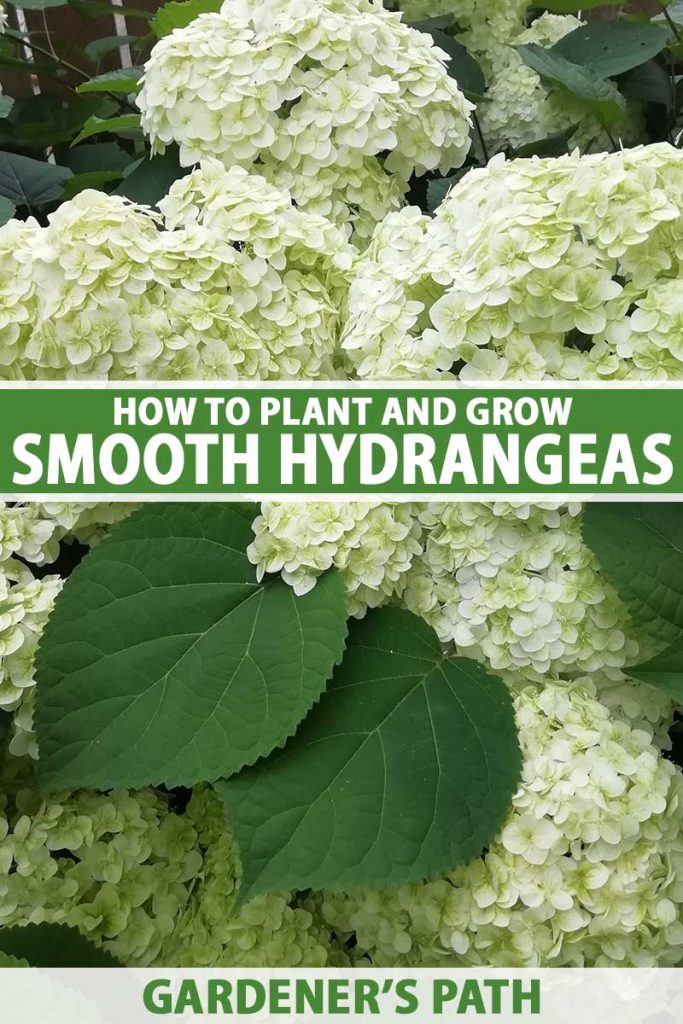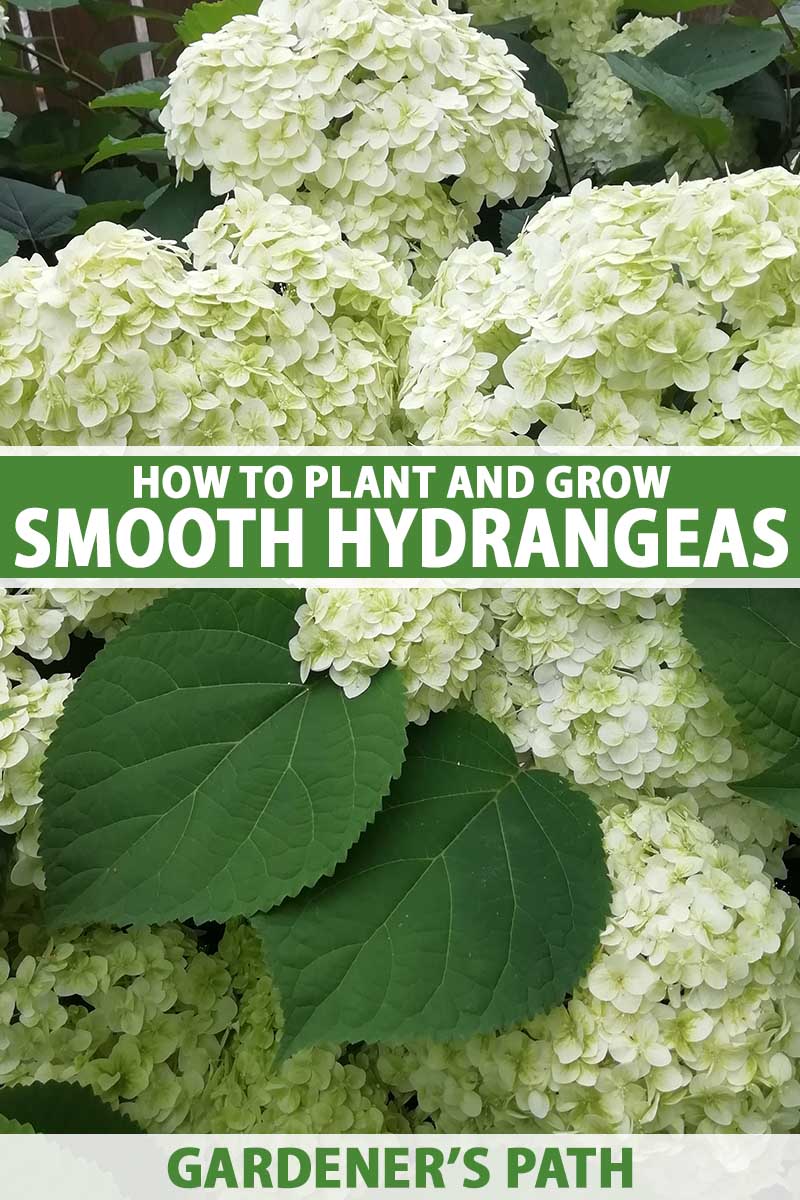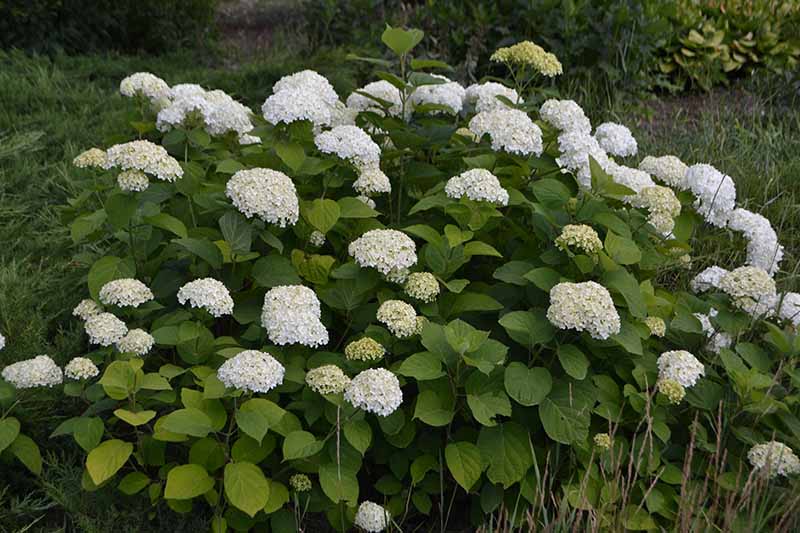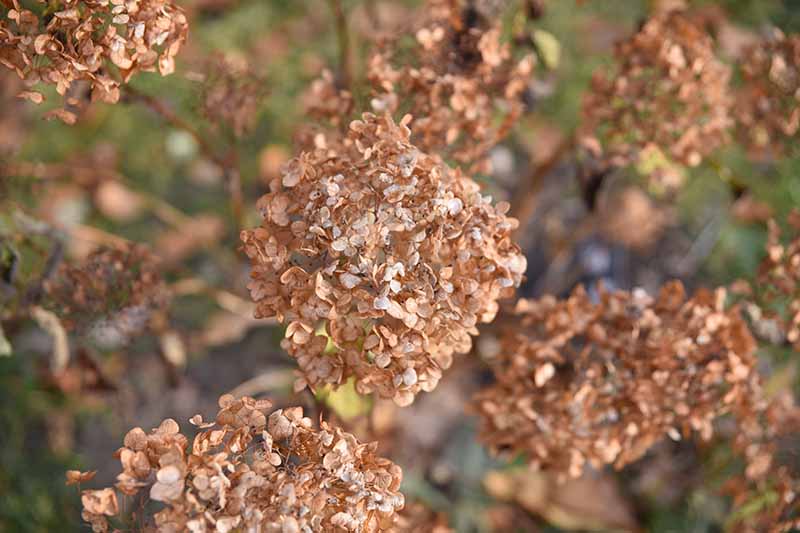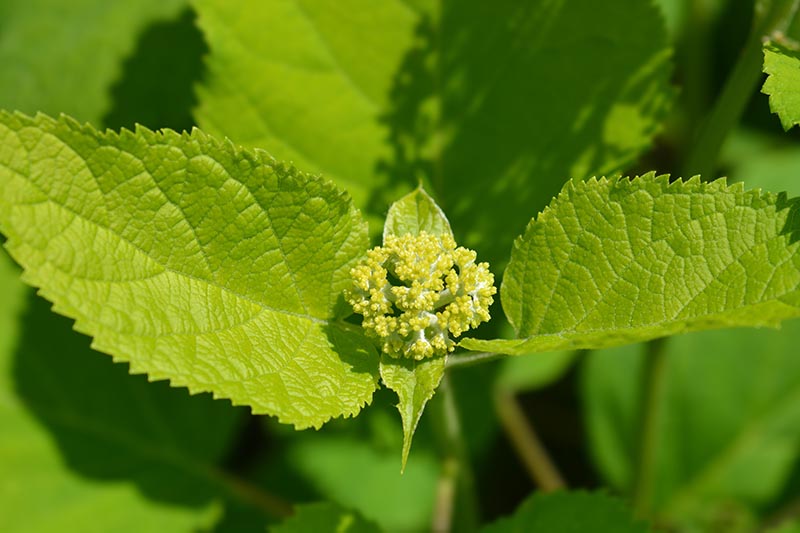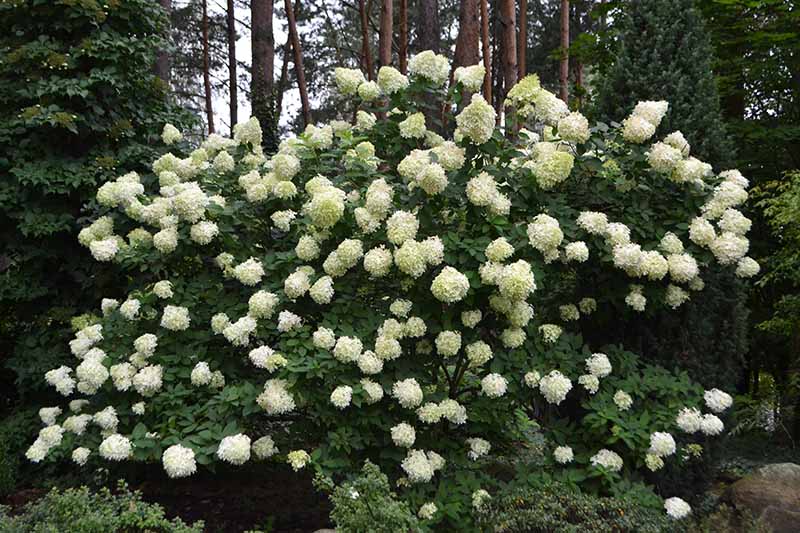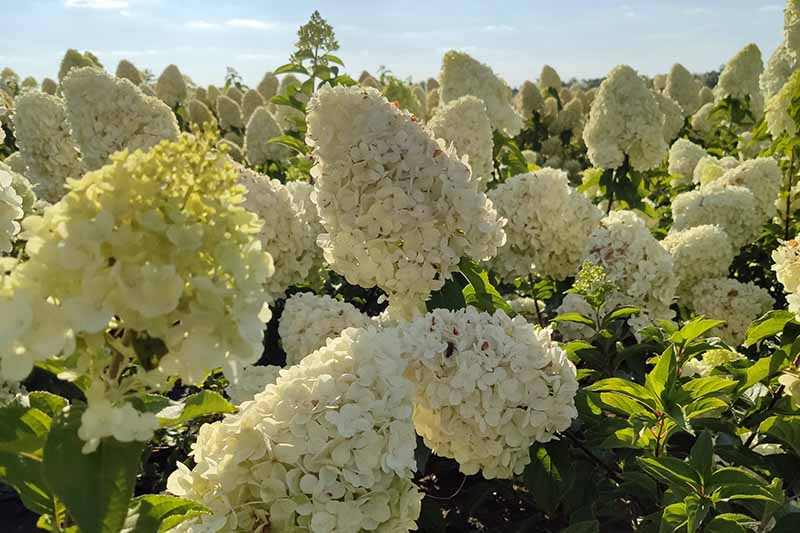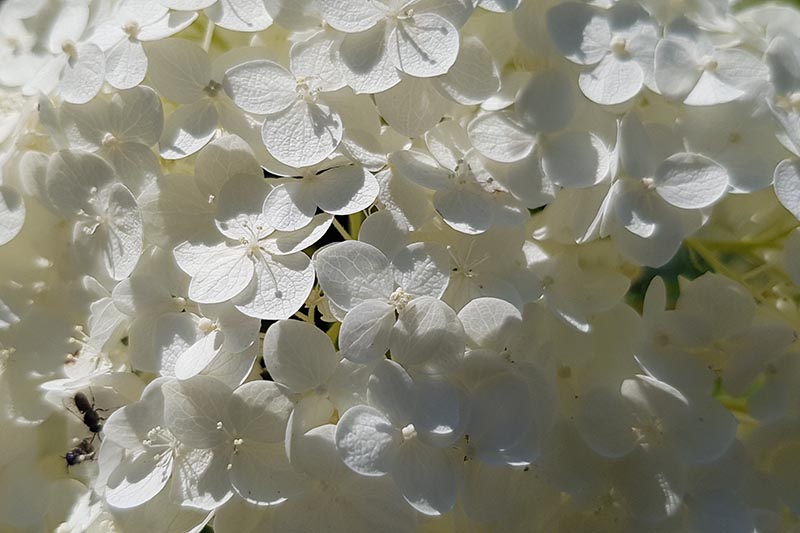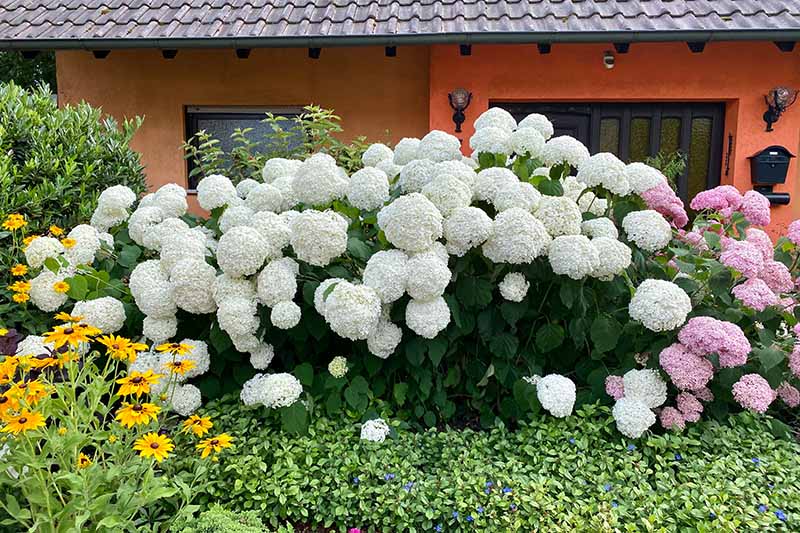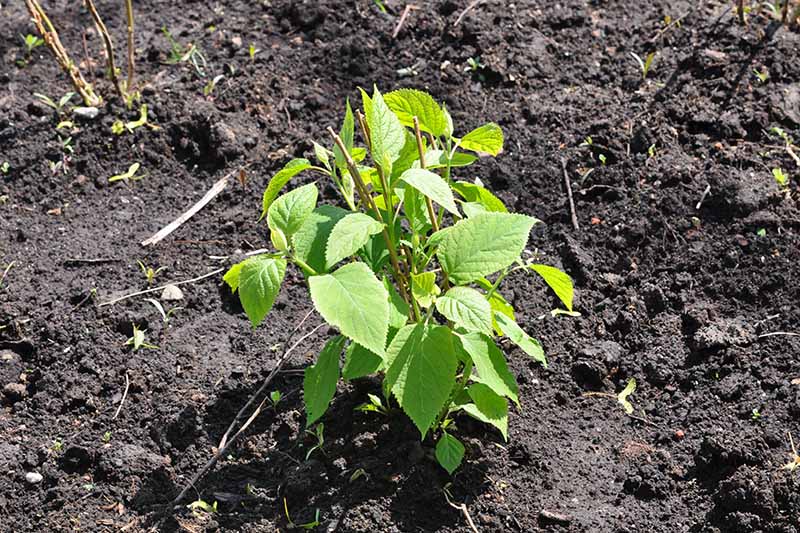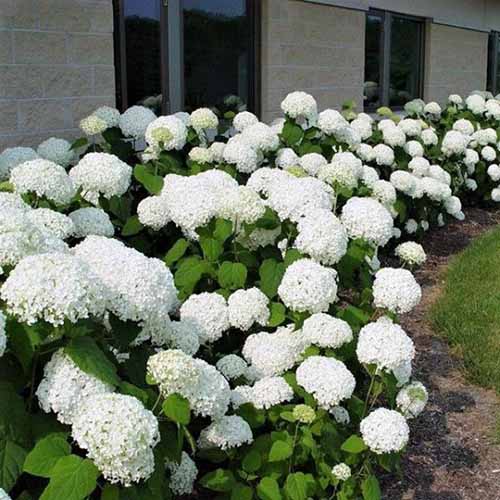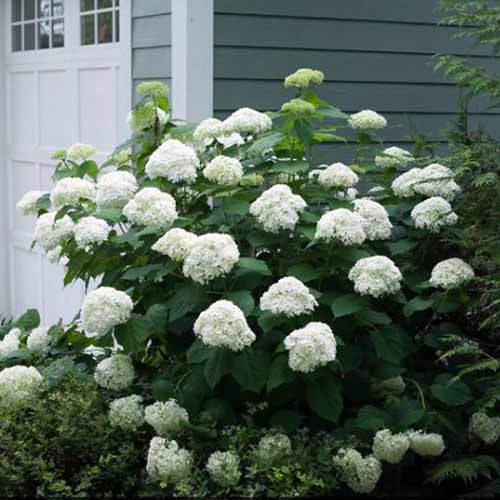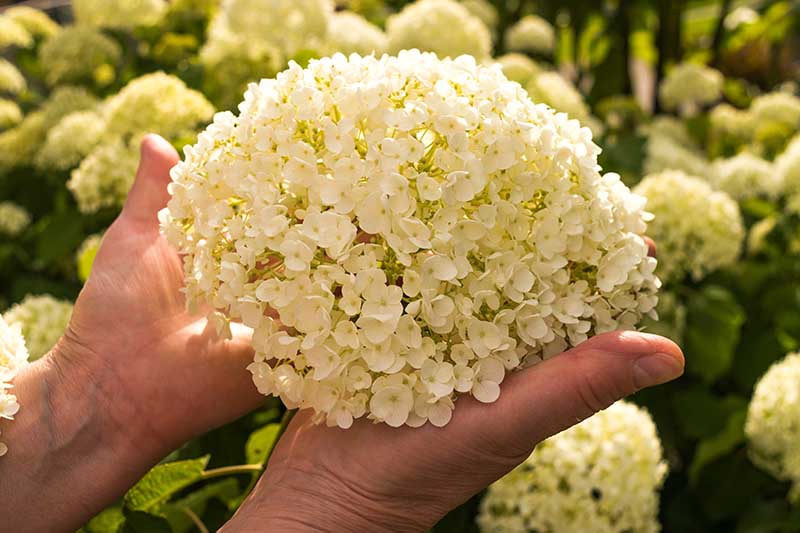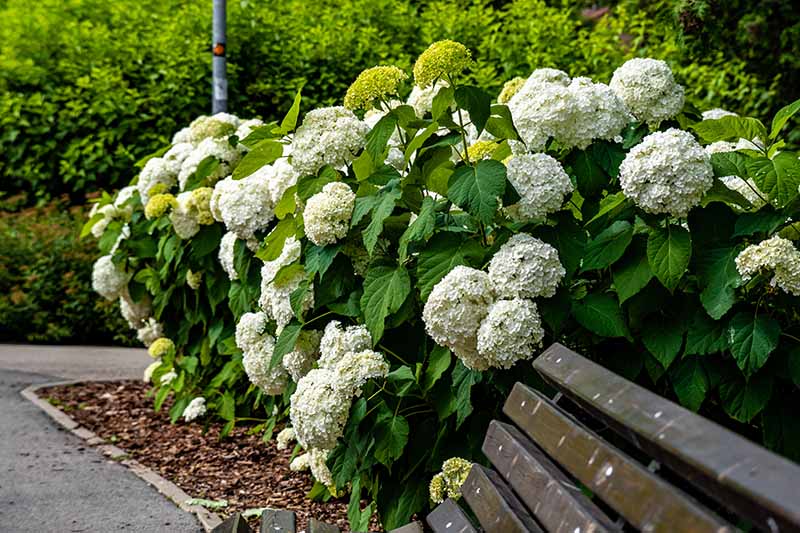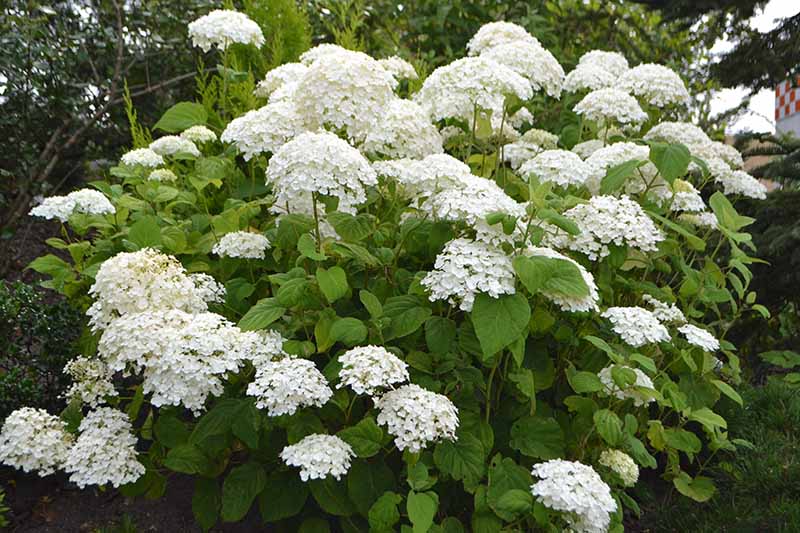With snow-white pom-pom inflorescence and exfoliating, textured bark, Hydrangea arborescens in particular is a festive garden staple. We link to vendors to help you find relevant products. If you buy from one of our links, we may earn a commission. Also known as smooth or wild hydrangea, H. arborescens serves as an excellent pollinator plant and slope stabilizer in habitat gardens and naturalized ornamental gardens. Its showy blooms make for an elegant cut flower, fresh or dried. And this species is easy to propagate too. Let’s get started:
What Are Smooth Hydrangeas?
H. arborescens goes by many names. Most commonly known as “smooth” or “wild hydrangea,” they are sometimes referred to as “sevenbark” or “tree hydrangea” for the plant’s attractive textured, peeling bark, or even “hills of snow,” in reference to their striking displays of white flowers, sprinkled across hillsides as if they were snow.
Deciduous, mounding shrubs, H. arborescens grow to three to five feet, often growing wider than they are tall. These dense, multi-stemmed perennials produce clusters of showy green-white flowers. The delicate yet vibrant flower clusters are the plant’s main appeal, providing abundant blooms throughout summer.
Flowers mature from a greenish-white hue to snow white, then dry to an attractive aged brown before giving way to cup-like seed capsules in fall. Unlike most hydrangeas, the flower color of wild hydrangeas is not affected by the soil pH. The multi-stemmed nature of the shrub gives way to full and lush foliage in spring and summer – a gentle thicket of ovular, opposite leaves with pointed tips and toothed margins. Dark green leaves with pale undersides turn yellow in fall, dropping to the ground in winter to expose the natural, multi-stemmed branching form.
The leaves of H. arborescens are thinner and slightly rougher than that of their cousin, French or big leaf hydrangea, H. macrophylla, though they still provide the same lush green feel to your garden.
H. arborescens is fast-growing, tending towards a suckering habit with new growth pushing up from the base of the plant. New stem growth appears smooth and tan, but as the plant matures, the bark crackles and peels back with age.
Cultivation and History
Smooth hydrangeas belong to the Hydrangeaceae family and are kin to about 80 species of other blooming hydrangea shrubs and vines native to North America and Asia. Smooth hydrangeas are typically found in moist, rocky forested areas, often clinging to the sides of streambanks, hillsides, and ravines.
You can find this species scattered throughout the eastern US, stretching across the southeastern region of the country up to New York. The genus name Hydrangea means water vessel in Greek, referencing the cup-like seed capsules and the plant’s affinity to water. The species name, arborescens, calls attention to the tree-like nature of the aged bark of this perennial understory plant. Used as medicine by the Cherokee people, the bark and leaves of wild hydrangeas have served as an antiseptic to soothe burns and sore muscles, as well as an emetic traditionally thought to alleviate stomach issues and high blood pressure.
Please note that while these indigenous medicinal practices may have been beneficial, the plant is mildly toxic to animals and humans. Though we honor the indigenous relationships to this plant, we don’t recommend trying these practices at home.
Propagation
H. arborescens can be grown by seed or cutting, but new plants are most easily propagated by root cuttings. Taking fresh cuttings from new growth is optimal.
You can always stick some cuttings in a glass of water to see what happens. This method is not the most reliable – but is always a fun experiment! For more information on how to propagate hydrangeas from cuttings check out our guide.
How to Grow
Smooth hydrangeas grow best in part shade, but may adapt to full sun with consistent water and rich soil conditions.
As their name suggests, they are water-loving plants, and without adequate moisture, their leaves will wilt and droop. Intolerant of drought, these plants may require some supplemental summer watering. Most easily grown in medium moisture, well-draining soil, it is best to plant wild hydrangeas in soil amended with organic material, either compost or mulch. Learn more about at-home composting systems here. Container plantings often require more frequent watering than they would if planted directly into the earth. Those grown in containers will need adequate drainage and nutrient-rich soil.
Growing Tips
Locate an area in your garden which receives partial sun, ideally morning sun with light afternoon shade. Ensure that the soil is well-draining – amend with gravel, mulch, and/or compost if necessary. Give the plant enough space to mature to full size (three to five feet). Provide regular morning watering. Container plants may require daily watering in summer.
Pruning and Maintenance
Smooth hydrangeas are generally low-maintenance plants. All that’s typically needed is a hard haircut in winter. Cutting the plant down to the ground – with just a few inches of stem remaining – encourages vigorous new growth when the plant wakes up from dormancy.
If you prefer to encourage upward growth you can elect to cut the plant back to one to three feet up from the soil level, but generally, the harder the haircut, the happier the plant. Come early spring, apply a slow release fertilizer with a balanced NPK ratio (10-10-10) to support strong root systems and healthy new growth.
Managing Pests and Disease
H. arborescens does not typically encounter severe problems caused by pests or disease. They can have both fertile and sterile flowers, with the fertile blooms forming lace-cap inflorescence while the sterile ones display mophead inflorescence, which is more pom-pom-like. Some cultivars, such as ‘Annabelle’ and ‘Incrediball,’ have only sterile flowers for a consistent ornamental snowball effect. H. arborescens ‘Annabelle’ is one of the most popular cultivars, accentuating the species’ showy, round flower clusters, often producing flower heads over 10 inches in diameter.
‘Annabelle’ Bare roots are available from Nature Hills Nursery, as well as live plants in a variety of sizes. ‘Incrediball’ is an improved selection, similar to ‘Annabelle’ but cultivated with stronger stems in order to support the massive, showy mophead flowers.
‘Incrediball’ And as their name suggests, the clusters of flowers are both ball-shaped and incredible, growing up to a foot in diameter! Plants in #3 containers are available from Nature Hills Nursery. ‘Haas Halo’ offers a more natural look with large lace-cap blooms, while ‘Hayes Starburst’ boasts star-shaped florets. Most commonly found with light green to white flowers, newer cultivars of this species possess pink to red flowers. Such cultivars include ‘Invincibelle Ruby’ and ‘Invincibelle Spirit’ with ruby red and pink flowers, and ‘Invincibelle Spirit II,’ which has pink flowers that age to an attractive green.
Occasionally, you may confront common garden insects on your plants, such as aphids, spider mites, or scale. A hard spray-down from the hose will help to alleviate the harm caused by aphids and spider mites, while mechanical removal followed by some soapy water or insecticidal spray is the best treatment for scale. The most common diseases found on smooth hydrangeas include bud blight, leaf spots, rust, and powdery mildew. While some fungicides can deter such diseases, the most foolproof (albeit sometimes taxing) form of care calls for manually removing all infected leaves or buds from the plant and landscape so as to prevent spread. Read more about hydrangea diseases here.
Best Uses
H. arborescens is an excellent woodland shrub for native plant gardens and slope stabilization projects. Flowers attract butterflies, bees, and other pollinators, while seeds serve as forage for songbirds.
For full effect, plant in swaths or groups to maximize floral abundance, or plant as a specimen species among other attractive shrubs. These plants look great as a natural garden border, or as a backdrop for lower-growing perennials or annuals.
Needless to say, the plant’s exuberant flower clusters make for an excellent bouquet – fresh or dried! Abundant shows of snowball flower clusters attract myriad pollinators, and cut flowers make for excellent bouquets.
Whether you’re looking for a statement piece, elegant border, or pollinator plant, smooth hydrangeas might just be the plant for your shady woodland garden. Now that you’ve learned so much about H. arborescens, let us know about your experience growing them in the comments section below! For more inspiration to cultivate a vibrant flower garden filled with beautiful hydrangeas, check out these articles next:
25 of the Best Hydrangea Varieties for Landscaping, Both Large & Small 7 Reasons Why Hydrangea May Not Bloom How to Grow and Care for Panicle Hydrangea
© Ask the Experts, LLC. ALL RIGHTS RESERVED. See our TOS for more details. Product photos via Nature Hills Nursery. Uncredited photos: Shutterstock.
